Salamanders are often informally divided into two groups, “true salamanders” and newts. These two groups are very similar but do have some differences. Salamanders typically have smooth moist skin while newts tend to have more rough, grainy skin.
Newts look somewhat like lizards. They have a slender body, a long tail, and four short legs. However, unlike lizards, newts do not have scales or claws. Instead, they have fleshy toes and usually have grainy slightly moist skin, but sometimes their skin is smooth.
Since they are semi-aquatic, their tails are usually flat and somewhat fin-like and not as rounded as those of lizards.
Newts begin their lives as aquatic larvae with a flat tail fin running down the length of their body, and wing-like gills attached to either side of their head.
As they grow, they grow through a process known as metamorphosis in which they lose these larval features and develop adult features. However, some newts will keep their larval features even as adults, this is known as “neoteny”.
Newts Will Look Different at Various Stages of Their Life Cycle
Newts go through 4 life stages: Egg, larvae, juvenile, and adult.

Female newts lay eggs and attach them to grass and other vegetation in breeding ponds. After a few weeks, these eggs hatch into tiny aquatic larvae with gills to help them breathe in the water.
With time, the larvae go through metamorphosis and transform into juvenile newts called “efts” that live a fully terrestrial life.
After 2 to 3 years, the efts will mature into adults that live a semi-aquatic life.
During these different life stages, newts will look very different.
What Newt Eggs Look Like
When the winter ends and the warmer spring temperatures arrive, newts will emerge from their overwintering spots and migrate to breeding ponds. In some newt species (such as the great crested newt), males will migrate to the breeding ponds first and wait for the females to arrive.
Once the females arrive, they will mate and lay their eggs. Egg laying typically lasts from 1 day to as long as 3 months depending on the species.
Unlike “true salamanders” or frogs, most newts do not lay their eggs in masses. Rather, female newts lay eggs singly and wrap each egg with the leaf of a pond plant using their back legs.
They do this to protect the eggs from predators, such as frogs, or even other newts.
Depending on the species, most newts can lay anywhere from 7 to as many as 400 eggs in a single breeding season. However, some newts such as the Spanish ribbed newt can lay up to a thousand eggs!
Here are pictures of what newt eggs look like:

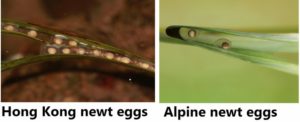
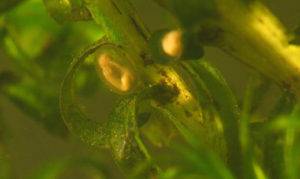
Most newt eggs have a whitish core surrounded by a layer of jelly. This jelly is usually clear or cloudy white, but sometimes has a tint of green, brown, or even orange depending on the species.
Some Newts Lay Their Eggs in Masses
Some newts such as the rough-skinned newt do not lay eggs singly. Rather, they lay their eggs in small masses containing about 10-20 eggs each. The egg masses are covered in an outer layer of jelly, kind of similar to how most “true salamanders” lay their eggs.
Here are pictures of what newt egg masses look like:
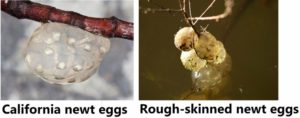

What Newt Larvae (Baby Newts) Look Like
After 2-3 weeks tiny aquatic larvae will hatch from the eggs. However, the time to hatching will vary widely depending on the specific species and environmental conditions. Some newt eggs may hatch after only a week, while others may take over a month before they hatch.
Baby newts, also called larvae, are fully aquatic and have a flat tail fin running along the length of their body to help them swim in the water. They also have external feathery gills attached to either side just where their necks should have been.
Here are some pictures of newt larvae:


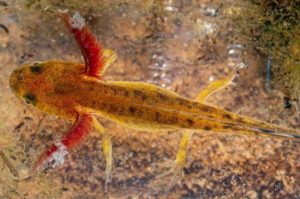
When they first hatch, they may have a yellow or white stripe of yolk along their belly. This stripe provides them nutrients for the first few days of their life before they start eating.
After a few days, the stripe of yolk will disappear, the tail will become broader, and the front legs will emerge.
The exact coloration of the larvae also varies widely depending on the species.
The larvae of some newts such as the great crested newt will have botches of dark pigmentation on their tail, while the larvae of other newts will have a fairly even coloration all over their body.
What Juvenile Newts Look Like
After a few months, the larvae will go through a process known as metamorphosis. This is a process in which they lose their larval features adapted for life in the water, and develop features more suitable for life on land.
During metamorphosis the larvae will go through the following:
- Their gills will shorten and eventually be absorbed into the head
- They will develop lungs for breathing air
- They will develop strong legs for walking long land
- Their flat tail will shorten and become more rounded
Once this process is fully complete, the larvae will leave the water as juveniles (also known as efts) and live a fully terrestrial life.
Here Are Some Pictures of What Juvenile Newts Look Like:

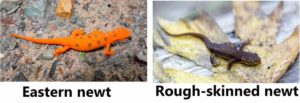
Juvenile newts will spend most of their time in wooded areas hiding under logs, rocks, and other debris until they mature into adults. In most newt species, this typically takes about two to four years.
What Adult Newts Look Like
Unlike juvenile newts, adult newts live a semi-aquatic life, meaning they spend part of their life in the water, and part on land.
Some newts, such as the rough-skinned newt, will spend most of their time on land, while other newts such as the eastern newt will spend most of their time in the water.
Like the juveniles, adult newts have four legs, long tails, and lizard-like bodies. They do not have claws or scales as lizards do.
Instead, they have fleshy toes and usually have dry grainy skin out of the breeding season, but may develop smooth moist skin when they migrate to the water to breed.
Their size varies ranging from as small as 2 inches (palmate newt), to as large as 12 inches (Spanish ribbed newt).
Here is what a few adult newts look like:
What Smooth Newts Look Like


Smooth newts are sometimes referred to as “common newts”. These newts are fairly small, only growing between 3 and 4 inches in length, with males being larger than females.
Smooth newts generally have a dull brown to olive coloration, with small dark spots, and a yellowish-orange underside.
The spots sometimes form rows of irregular lines along the back and are larger on males than on females.
The underside has small dark spots and is usually paler in females.
Most times of the year, smooth newts live on land and have dry water-repellent skin with a velvety texture. However, during the breeding season, they develop smooth moist skin and a more flattened fin-like tail.
The males also develop a more vivid color pattern and a translucent wavy crest that runs from their heads to their tails.
Smooth newts are native to the UK and much of Europe but have also been introduced to Australia.
What Palmate Newts Look Like



Like the smooth newt, palmate newts are on the smaller side, reaching only between 2 and 3.7 inches in length. Females are generally larger than males.
Palmate newts look very similar to smooth newts, and since they occur in the same range, it can be difficult to tell them apart. Both are brown to olive in color with small dark spots and have a yellow/orange underside.
The easiest way to tell them apart is:
- The spots on the underside of the smooth newt extend all the way to the throat
- Palmate newts never have spots on their throat.
Like the smooth newt, palmate newts have dry skin with a velvety texture, but their skin becomes smooth and moist when they migrate to the water to breed.
Breeding males also develop a low smooth crest, black webbing on the back feet, and a filament at the tip of the tail.
Palmate newts can be found throughout much of western Europe.
What Great Crested Newts Look Like


Great crested newts are sometimes called “northern crested newts” or “warty newts”. These newts reach between 5 and 7 inches, which makes them one of the largest newt species in Europe. Females are typically larger than males.
Great crested newts have a dark brown to black coloration and have rough grainy skin, with white stippling (dots) on the sides.
The underside is bright orange with irregular black blotches’ which turn into fine dots on the throat.
During the breeding season, male great crested newts develop a magnificent jagged crest along their backs (hence their name). This crest is interrupted at the tail base and gets smoother on the tail.
Great crested newts can be found from the UK and throughout much of western Europe all the way to Russia.
What Rough-Skinned Newts Look Like
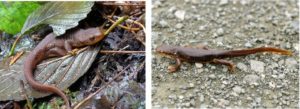
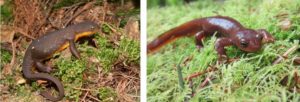
Rough-skinned newts are on the larger side, growing between 5 to 8 inches in length. As their name suggests, these newts have rough grainy skin.
You can identify these newts by their light brown to blackish-brown coloration, with a light orange to yellow color on the underside (including the legs and tail).
During the breeding season, male rough-skinned newts will develop smooth slippery skin and a flat tail fin. Their coloration also becomes lighter.
These newts can be found throughout the Pacific Northwest coast of North America, all the way to Alaska.
What Eastern Newts Look Like
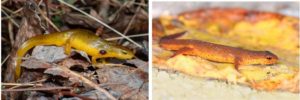

Eastern newts are fairly small, only growing between 2.5 and 5 inches in length. They have rough skin that is slightly moist, (just enough to keep it from drying out).
There are 4 subspecies of the eastern newt:
- Red-spotted newt
- Broken-stripped newt
- Central newt
- Peninsula newt
All these subspecies are extremely similar to each other and only have very minor differences.
In the Juvenile eft stage (which lasts about 3 to 4 years), they have a bright orange-red coloration with a rounded tail.
As adults eastern newts generally have a yellowish-brown to greenish-brown coloration, with black-bordered red spots along their back. The underside is yellow with small dark spots.
Males develop enlarged hind legs and a high wavey crest on their tails during the breeding season.
Eastern newts are native to the eastern parts of the United States, from Florida, and all the way up to Canada.
What Fire Belly Newts Look Like

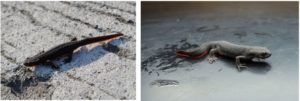
Fire belly newts are mediumly sized, growing between 3 and 5 inches in length. They have a brownish-black coloration and get their name from the vivid orange-red blotches’ on their underside.
There are two well-known species of fire belly newts, the Chinese, and the Japanese fire belly newt. These two newt species look very similar and can be hard to tell apart. In fact, many newts labeled as Japanese fire belly newts in the pet trade, are actually Chinese fire belly newts instead.
The main differences between these two newts are:
- The Japanese fire belly newt is larger, has rough grainy skin, large parotid glands, and a flat tail
- The Chinese fire belly newt is smaller, has smoother skin, smaller less obvious parotid glands, and a rounder tail
Apart from these differences, these newts are almost identical.
Chinese and Japanese fire belly newts are native to China and Japan respectively.
What Kaisers Mountain Newts Look Like


The Kaisers mountain newt, also called the ” Kaisers spotted newt” or the “Luristan Newt” typically grows between 4 and 5 inches in length.
These newts get their name from the small area of Iran (the Zagros Mountains) where they are found.
You can identify them by their black back with pale white spots and the narrow orange-red stripe running from their neck to the base of the tail.
Their underside is whitish orange-red, and sometimes has black markings, and their legs are orange-red with black and white markings.
Kaiser’s mountain newts are native only to the Zagros Mountains and are listed as vulnerable due to uncontrolled harvesting for the pet trade. However, they are actively bred by many European and American Zoos.
What Alpine Newts Look Like


Alpine newts are mediumly sized newts, measuring between 2.8 and 5 inches in length, with females being larger than males. They have a blue-gray to olive coloration with barely visible light spots, which give them a marbled appearance.
Males have a white band with black spots and a light blue flash on their sides, running down the length of their bodies. The underside of both males and females is orange without any spots or markings.
Most times of the year, alpine newts live on land and have rough grainy skin. However, during the breeding season, they migrate to the water and develop smooth moist skin.
Male alpine newts also develop a small crest with yellowish-white and black stripes.
These newts are native to much of the continent of Europe but have also been introduced to New Zealand and the UK.
What Marbled Newts Look Like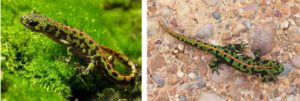

Marbled newts are fairly large, measuring between 5 and 7 inches in length. As their name suggests, these newts have a marbled appearance.
They have a dark brown to black coloration with irregular patterns of marbled green. Female and juvenile marbled newts have a yellow or orange stripe running from their head to tail, however, this stripe fades in males as they reach maturity.
The underside of both males and females is dark brown or black with small white spots.
Most times of the year, male marbled newts have a small crest running from the base of the head to the tail. However, during the breeding season, this crest becomes much larger and is green with vertical black bands.
Marbled newts are found in Southern Europe, from Portugal to France.
What Spanish Ribbed Newts Look Like


Spanish ribbed newts are also called “Iberian ribbed newts”, or simply “sharp ribbed newts”. These newts grow between 7 and 12 inches, which makes the largest newt species in Europe, and one of the largest in the world.
Spanish ribbed newts get their name from their unusual defense mechanism of using sharp ribs which can puncture through their sides.
These newts are highly aquatic their whole life, and very rarely leave the water (although they can walk on land).
They have rough olive-brown skin, with irregular black spots. Their underside is the same color as their back, only lighter and with the same black spotting.
That said, adult males and females look different. The male newts have slender bodies with narrow heads compared to females. They also have long front legs, which look disproportionate to the rest of the body.
Females ribbed newts have large broad heads and a stockier body when compared to males.
Despite their name, these newts are not only native to Spain, they can also be found in Portugal and Morocco.
What Sword-Tail Newts Look Like


Sword-tail newts are large and grow between 5 and 7 inches in length. They get their name from their pointed tails, which resemble swords.
Sword-tail newts typically have a black or dark brown coloration with a bright orange underside. Sometimes, they are called fire-bellied newts because of the coloration of their underside.
However, they are not to be confused with the Chinese and Japanese fire belly newts.
They can be differentiated from these two species by their larger size, broader heads, and generally smoother skin. Also, they have a very prominent ridge running down their back.
Sword-tail newts are native only to a few islands off the coast of Japan, but they are fairly common in the pet trade.
What Paddle Tail Newts Look Like


Paddle-tail newts are fairly large, growing about 6-7 inches in length. They get their name from their broad flat tail, which somewhat looks like a paddle.
These newts have smooth dark brown to black skin, with an orange to red underside. They have orange markings along the bottom of their bodies and may have some orange dots lining their backs.
Paddle-tail newts are fairly common in the pet trade, and are sometimes mistakenly labeled as “fire belly newts”, but they are a completely different species.
These newts are native only to China.
Sometimes, Adult Newts Have Gills
Sometimes, newts mature into adults while still in their larval form, without first going through the process of metamorphosis.
This is known as “neoteny”.

Neotenic adult newts look just like really large larvae. They keep their external gills, flat fan-like tails, and other larval features. They also live entirely in the water, just like the larvae.
Neoteny usually happens when the conditions on land are particularly harsh (such as excessively cold, or dry), making it necessary for the larvae to remain in the water.
The Weirdest Looking Newts
Imagine a newt with rough dark-colored skin, a broad bony head, and rows of light-colored wart-like growths along its back. If you imagined the Laos warty newt, you are correct!
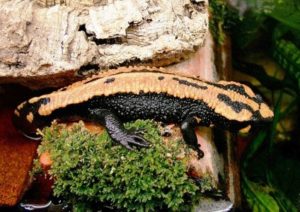
These newts are occasionally just called “Warty Newts” and are fairly common in the pet trade. Warty newts are mediumly sized and measure between 3.5 and 6 inches.
They are native to Laos, where they are only found in 2 areas. Recently, they have been listed as endangered, mainly due to harvesting for the pet trade.
Crocodile Newts
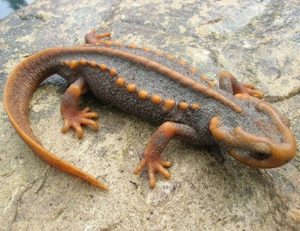
Crocodile newts are fairly large, typically reaching between 5 and 8 inches in length. They are sometimes called “knobby newts” are actually a genus with 32 species, rather than a single newt species.
All these species have a similar appearance, with their main difference only being coloration. They generally have rough dry skin, a broad bony head, and a prominent ridge of their back flanked by two rows of raised bumps.
The exact coloration varies between different species. Some are mostly black or dark brown while others have a more colorful pattern.
Crocodile newts are native to Asia where they range from Northeastern India all the way to Vietnam and China.
Final Thoughts
There are lots of newt species that all look somewhat different from each other. However, they do share a few common features.
They have a slender lizard-like body, 4 short legs, and a long tail. Some have dry rough skin, while others have smooth moist skin.
Also, in the breeding season, some newts may develop features that make them look different from what they look like most times of the year.
Now you know how to easily recognize a newt the next time you see one!
Photo credits: California Department of Fish and Wildlife/Wikimedia Commons. Bill Bouton/Wikimedia Commons. Gilles San Martin/ Wikimedia Commons. Bernard DUPONT/Wikimedia Commons. Thomas Brown/ Wikimedia Commons. Neil Dalphin, CC0/ Wikimedia Commons.


